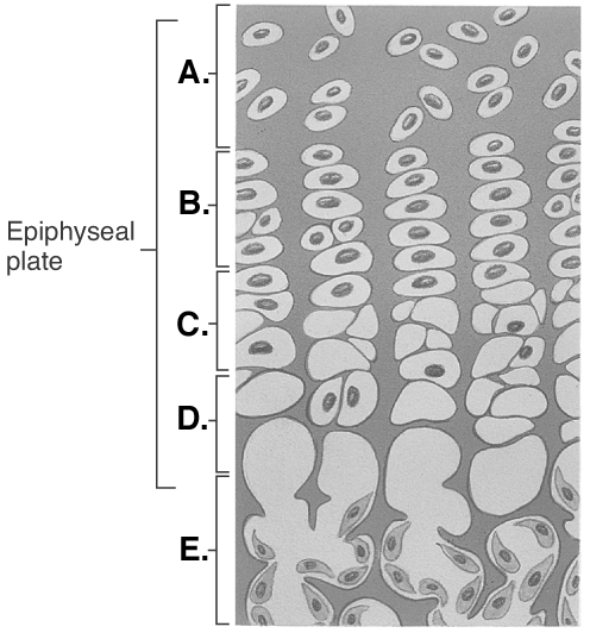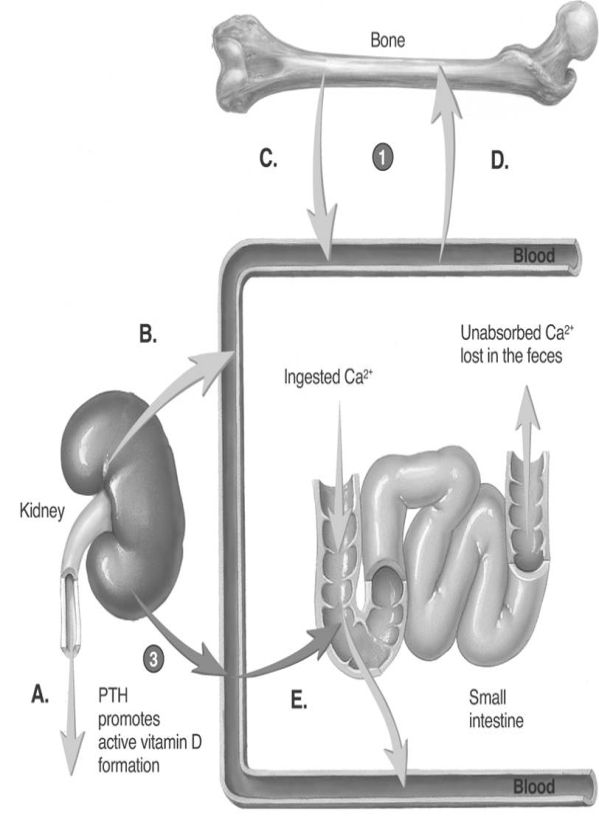A) cancellous bone
B) diaphysis
C) epiphyseal lines
D) articular cartilage
E) epiphysis
G) A) and E)
Correct Answer

verified
Correct Answer
verified
Multiple Choice
 -This figure illustrates bone growth in length at the Epiphyseal Plate. What is zone "C"?
-This figure illustrates bone growth in length at the Epiphyseal Plate. What is zone "C"?
A) bone of diaphysis
B) zone of calcification
C) zone of hypertrophy
D) zone of proliferation
E) zone of resting cartilage
G) C) and D)
Correct Answer

verified
Correct Answer
verified
Multiple Choice
Proteoglycan molecules in the matrix of cartilage
A) replace collagen fibers in the matrix.
B) give cartilage its resilient nature.
C) fill the lacunae.
D) make the perichondrium very stretchable.
E) make cartilage hard and compact.
G) A) and D)
Correct Answer

verified
Correct Answer
verified
Multiple Choice
Osteomalacia is
A) bone inflammation that often results from bacterial infection.
B) a disease in adults, especially women, characterized by a reduced amount of bone matrix.
C) a disease in adults characterized by softening of bones resulting from calcium depletion.
D) a disease in children characterized by soft, bowed, and swollen bones.
E) a group of genetic disorders producing very brittle bones that are easily fractured; occurs because of insufficient collagen development.
G) A) and E)
Correct Answer

verified
Correct Answer
verified
Multiple Choice
 -This figure illustrates bone growth in length at the Epiphyseal Plate. What is zone "A"?
-This figure illustrates bone growth in length at the Epiphyseal Plate. What is zone "A"?
A) bone of diaphysis
B) zone of calcification
C) zone of hypertrophy
D) zone of proliferation
E) zone of resting cartilage
G) A) and E)
Correct Answer

verified
Correct Answer
verified
Multiple Choice
The medullary cavity is
A) empty in adult bones.
B) the site where osteoblasts are found.
C) lined with endosteum.
D) filled with fibrocartilage and elastin fibers.
E) dead space in the bone.
G) A) and B)
Correct Answer

verified
Correct Answer
verified
Multiple Choice
How does the nervous system contribute to osteoporosis?
A) inadequate amounts of calcium and vitamin D in the diet
B) lack of exercise reduces muscle stress on bone
C) pain following injury helps prevent further injury
D) blood clotting starts repair process
E) calcitonin is used to treat osteoporosis
G) A) and C)
Correct Answer

verified
Correct Answer
verified
Multiple Choice
An X-ray determines that Peter fractured the shaft of his humerus. The break is in the _____________ of the bone.
A) epiphysis
B) epiphyseal line
C) diaphysis
D) growth plate
E) articular surface
G) C) and E)
Correct Answer

verified
Correct Answer
verified
Multiple Choice
Which of the following statements regarding PTH (parathyroid hormone) is true?
A) PTH causes decreased uptake of Ca2+ from the small intestine.
B) PTH causes decreased vitamin D formation in the kidneys.
C) PTH causes increased reabsorption of Ca2+ in the kidneys.
D) PTH causes increased loss of Ca2+ from the kidneys.
E) PTH causes increased Na+ reabsorption in the kidneys.
G) A) and B)
Correct Answer

verified
Correct Answer
verified
Multiple Choice
What structure forms between the ends of a broken bone and also the marrow cavities?
A) hematoma
B) internal callus
C) external callus
D) compact bone
F) A) and C)
Correct Answer

verified
Correct Answer
verified
Multiple Choice
The spaces between developing skull bones that have not ossified are called
A) epiphyseal plates.
B) articular cartilages.
C) fontanels.
D) bone collars.
E) medullary cavities.
G) B) and D)
Correct Answer

verified
Correct Answer
verified
Multiple Choice
Bone remodeling may occur
A) as bones grow.
B) as bones adjust to stress.
C) as fractures heal.
D) constantly during a person's lifetime.
E) All of these choices are correct.
G) B) and E)
Correct Answer

verified
Correct Answer
verified
Multiple Choice
Which of the following is NOT an effect of parathyroid hormone (PTH) ?
A) increased Ca2+ uptake by the small intestine
B) increased vitamin D formation in the kidneys
C) increased Ca2+ reabsorption by the kidneys
D) decreased Ca2+ loss by the kidneys
E) All of these are effects of PTH.
G) A) and D)
Correct Answer

verified
Correct Answer
verified
Multiple Choice
Which type of bone cells lie in lacunae?
A) osteochondral progenitor cell
B) osteoblasts
C) osteocytes
D) osteoclasts
F) None of the above
Correct Answer

verified
Correct Answer
verified
Multiple Choice
Which type of bone cells possess extensive ER and ribosomes?
A) osteochondral progenitor cell
B) osteoblasts
C) osteocytes
D) osteoclasts
F) B) and C)
Correct Answer

verified
Correct Answer
verified
Multiple Choice
 -This is a diagram of calcium homeostasis. What process is represented by "C"?
-This is a diagram of calcium homeostasis. What process is represented by "C"?
A) PTH promotes calcium release into blood by osteoclast.
B) Calcium is removed from blood by osteoblasts.
C) Vitamin D promotes calcium absorption.
D) Calcium is lost in urine.
E) PTH promotes calcium reabsorption from urine.
G) A) and E)
Correct Answer

verified
A
Correct Answer
verified
Multiple Choice
A young boy (10 years old) exhibited the following symptoms: advanced development of secondary sexual characteristics and rapid growth. Which of the following caused his condition?
A) hypersecretion of growth hormone
B) hypersecretion of testosterone
C) hypersecretion of estrogen
D) hyposecretion of estrogen
E) hypersecretion of vitamin D
G) B) and D)
Correct Answer

verified
B
Correct Answer
verified
Multiple Choice
What strengthens the attachment of the tendons or ligaments to bone?
A) epiphysis
B) Sharpey fibers
C) growth plate
D) medullary cavity
E) endosteum
G) A) and E)
Correct Answer

verified
Correct Answer
verified
Multiple Choice
A bone fracture that does not perforate the skin is a(an)
A) open fracture.
B) closed fracture.
C) complicated fracture.
D) composite fracture.
E) irregular fracture.
G) A) and C)
Correct Answer

verified
B
Correct Answer
verified
Multiple Choice
What chemical causes an increase in the blood calcium level?
A) growth hormone
B) sex hormones
C) parathyroid hormone
D) calcitonin
E) vitamin D
G) C) and D)
Correct Answer

verified
Correct Answer
verified
Showing 1 - 20 of 150
Related Exams